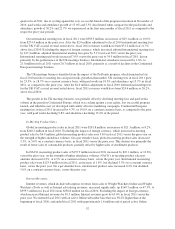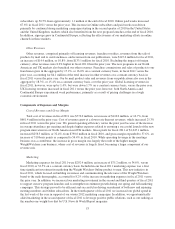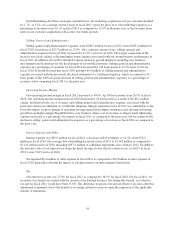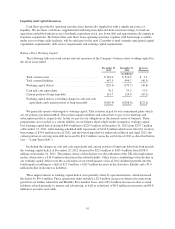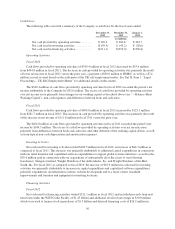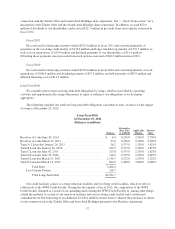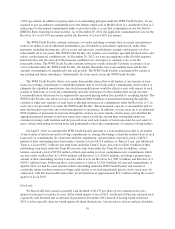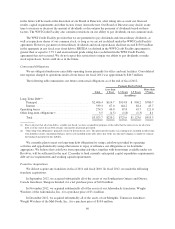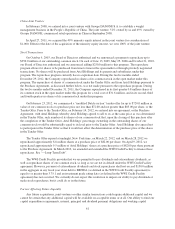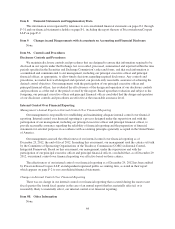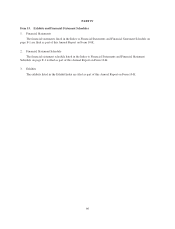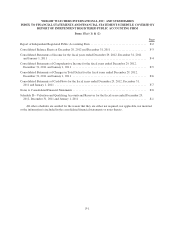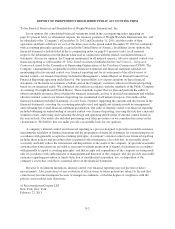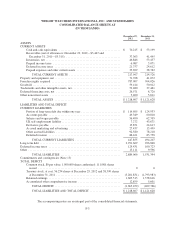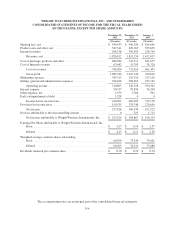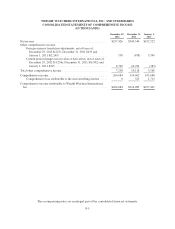WeightWatchers 2012 Annual Report Download - page 78
Download and view the complete annual report
Please find page 78 of the 2012 WeightWatchers annual report below. You can navigate through the pages in the report by either clicking on the pages listed below, or by using the keyword search tool below to find specific information within the annual report.requirements and to comply with all of the financial covenants under our debt agreements depends on our future
operations, performance and cash flow. These are subject to prevailing economic conditions and to financial,
business and other factors, some of which are beyond our control.
Off-Balance Sheet Transactions
As part of our ongoing business, we do not participate in transactions that generate relationships with
unconsolidated entities or financial partnerships established for the purpose of facilitating off-balance sheet
arrangements or other contractually narrow or limited purposes, such as entities often referred to as structured
finance or special purpose entities.
Related Parties
For a discussion of related party transactions affecting us, see “Item 12. Certain Relationships and Related
Transactions, and Director Independence” in Part III of this Annual Report on Form 10-K.
Seasonality
Our business is seasonal, with revenues generally decreasing at year end and during the summer months.
Our operating income for the first half of the year is generally the strongest. Our advertising schedule generally
supports the three key recruitment-generating seasons of the year: winter, spring and fall, with winter having the
highest concentration of advertising spending. The timing of certain holidays, particularly Easter, which precedes
the spring marketing campaign and occurs between March 22 and April 25, may affect our results of operations
and the year-to-year comparability of our results. The introduction of Monthly Pass in the meetings business has
resulted in less seasonality with regard to our meeting fee revenues because its revenues are amortized over the
related subscription period. While WeightWatchers.com experiences seasonality similar to the meetings business
in terms of new subscriber sign-ups, its revenue tends to be less seasonal because it amortizes subscription
revenue over the related subscription period.
Recently Issued Accounting Pronouncements
In July 2012, the Financial Accounting Standards Board, or the FASB, issued updated guidance on the
periodic testing of indefinite-lived intangible assets for impairment. This guidance allows companies to first
assess qualitative factors to determine if it is more-likely-than-not that an indefinite-lived intangible asset might
be impaired and whether it is necessary to perform the quantitative impairment test required under current
accounting standards. This guidance is applicable for fiscal years beginning after September 15, 2012, with early
adoption permitted. The Company adopted the provisions of this guidance in the third quarter of fiscal 2012. The
adoption of this guidance did not have any affect on the consolidated financial position, results of operations or
cash flows of the Company.
In September 2011, the FASB issued updated guidance on the periodic testing of goodwill for impairment.
This guidance allows companies to assess qualitative factors to determine if it is more-likely-than-not that
goodwill might be impaired and whether it is necessary to perform the two-step goodwill impairment test
required under current accounting standards. This guidance is applicable for fiscal years beginning after
December 15, 2011, with early adoption permitted. The Company adopted the provisions of this guidance in the
first quarter of fiscal 2012. The adoption of this guidance did not have any affect on the consolidated financial
position, results of operations or cash flows of the Company.
In June 2011, the FASB issued authoritative guidance requiring companies to present the total of
comprehensive income, the components of net income and the components of other comprehensive income either
in a single continuous statement of comprehensive income or in two separate but consecutive statements. The
provisions of the guidance are effective for fiscal years, and interim periods within those years, beginning after
December 15, 2011. In December 2011, the FASB issued an amendment deferring the effective date for the
62


